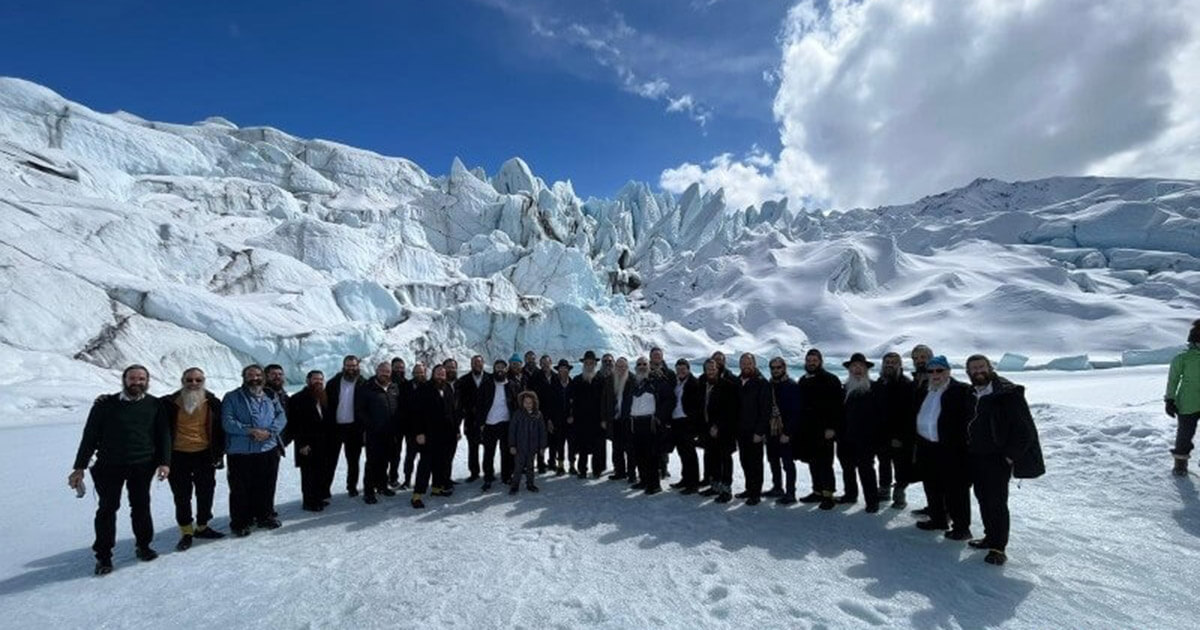The forgotten U.S. plan to send Jewish refugees to Alaska — and why it matters today
The Last Frontier is now home to about 6,000 Jews.

The 2023 regional conference of Chabad-Lubavitch emissaries met at the Matanuska Glacier in Alaska. Courtesy of Rabbi Mendy Greenberg
Rabbi Mendy Greenberg stepped onto his porch in Palmer, Alaska, on a recent afternoon, taking in the vast, snow-covered expanse before him. “We’re surrounded by beautiful mountains,” he said over the phone to this reporter in the Lower 48. “It’s breathtaking.”
Greenberg, a Chabad rabbi, has spent most of his life in the Last Frontier, helping to sustain Jewish life in a place never meant to be a major Jewish hub. But more than 80 years ago, U.S. officials briefly considered a plan that could have changed that — one that proposed sending thousands of Jewish refugees to Alaska as they fled Hitler’s Germany.
The plan, known as the Slattery Report, died in Congress and was then forgotten. But now, as President Donald Trump talks about permanently relocating 2.2 million Palestinians from Gaza, the abandoned proposal to move an entire population from one country to another is suddenly historically resonant.
In 1939, as war loomed over Europe, Interior Secretary Harold Ickes and his aide Harry Slattery championed the plan. The proposal, researched by Felix Cohen, a Jewish civil servant, was framed as both a humanitarian effort and a strategic boon to a young territory. But it also carried a totemic weight — the idea that vast, empty landscapes could be repurposed for human crisis management, as if geography alone could absorb the world’s displaced.
The thinking was twofold: Jews needed a refuge, and Alaska — still a sparsely populated U.S. territory — could use more settlers to strengthen its economy and fortify its defenses against Japanese expansion in the Pacific.
But while the plan made it as far as Congress, it was dead almost on arrival. Immigration quotas remained tight, and political opposition was fierce. Even in Alaska, the plan was met with resistance. One of its most surprising opponents was Ernest Gruening, the governor of the Alaskan territory — who was himself Jewish.

“Gruening had initially been for it,” said historian Rebecca Brenner Graham, but he changed his mind “because of a rivalry with Ickes and especially because the idea was unpopular in Alaska.”
Meanwhile, Jewish refugees wrote desperately to U.S. officials, often beginning their letters with “Dear Miss Perkins…,” referring to Frances Perkins, Roosevelt’s Secretary of Labor who oversaw the Immigration and Naturalization Service.
Perkins, who was the first woman to serve in a president’s cabinet, sympathized with the Jewish plight. But political realities made it nearly impossible for her to push for expanding immigration quotas. Graham, the author of a new book on Perkins, noted that while she was deeply concerned about the refugee crisis, congressional opposition kept the U.S. doors largely closed.
The fictional Jewish Alaska
The Slattery Report never became reality, but it inspired an unusual legacy: an alternate history in fiction.
In The Yiddish Policemen’s Union, Pulitzer Prize-winning author Michael Chabon imagines a world where Congress implemented the Slattery Report, and Jewish refugees settled in Sitka, Alaska. In his version, millions of Jews are saved from the Holocaust, creating a Yiddish-speaking enclave in the frozen north.
It’s a haunting thought experiment — how different history might have been if the Slattery Report was implemented. But the reality was that no such mass migration happened.
Jokes about the “Frozen Chosen” aside, living in Alaska is not simple for the roughly 6,000 Jews that reside there, especially the observant ones. In summer, sunset is so late that Friday night dinner might not start until after 9:30 p.m. Shabbat doesn’t end until early Sunday morning.
Greenberg, 35, has lived in Alaska since 1991, when the Lubavitcher Rebbe sent Greenberg’s father to be the state’s first full-time Chabad rabbi. The Rebbe told the family in Yiddish, “Makhn dort varem” — “make it warm there.”
“We see that as our mission,” Greenberg said. “Everyone thinks of Alaska as a cold place, a hard place, a rough place. But the Rebbe empowered us to make it warm and bright and make every Jew feel at home.”
Greenberg can’t imagine being anywhere else. “If anyone wants to marvel in God’s creation,” he said, “come here to Alaska.”
















